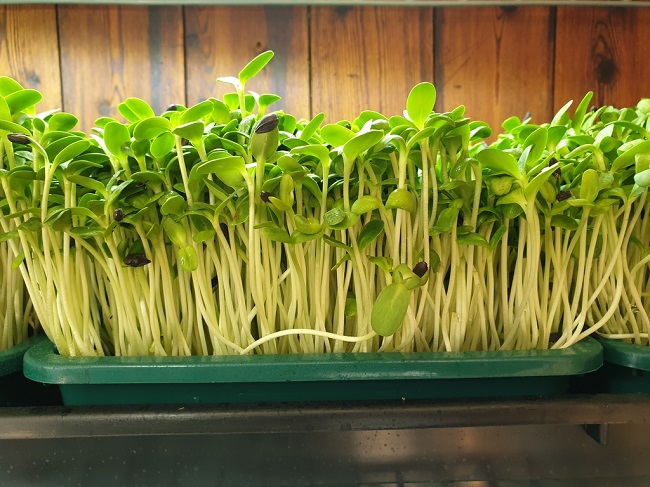
Micro greens are tiny plants with a great deal of potential. The term “Micro green” is used to describe the two-inch version of any edible plant, usually with only the first leaves developed. They range in size from one to two inches long, including the stem and leaves. The micro green is cut from the root and sold in small packages or in flats with the roots intact, so clients can clip off fresh greens at will. Popular varieties include the Dikon Radish, Bulls Blood Beet, Arugula, and Basil but most growers can quickly switch over to any green that a client may request.
Within this first set of leaves is packed a concentrated source of nutrients, vivid color, and the intense flavor of the parent plant. First made popular in Japan as a common addition to sushi, the micro green has recently become a sought-after item in America. These miniature plants are increasingly seen in farmers markets, co-ops, juice shops, and health food stores. Where there is a local supply, you are almost certain to find them in the form of a garnish or salad in any fine dining restaurant. The rise in popularity is good news for small greenhouses looking for a niche to fill in their community.
A relatively small amount of space can produce a great deal more than the same greenhouse growing full grown varieties. For example, a 12’ x 2’ area can produce almost 1,800 pounds of micro greens per year if the greenhouse is utilized 365 days per year. The largest recurring expense will be seeds so it is important to find a good relationship with a supplier. The short turn-around and ease of propagation makes it an ideal crop for start-up greenhouses. Like any small business, greenhouses have a high rate of failure within the first few years which creates a very real fear of a lost crop. While it may take months to recover from a lost crop of a full-grown vegetable, a micro green grower can be back on track within a week.
Micro greens are easy to propagate and will grow from seed to ready-for-market product in 5-14 days. If you are presoaking seeds, use 3 times more water than seed and make sure the seeds stay soaked. If they dry out it may cause problems, but you can’t really have too much water. Most seeds do not need to be presoaked. Germinating seeds in fine grade vermiculite and then sowing the germinated seeds plus vermiculite will help things along but most will sprout anywhere. Place them in a warm, dark place until they sprout. Once sprouted, the plants need at least 8-10 hours of light each day. Many micro greens only need one watering after the initial moistening of your grow medium before they are ready to eat. They are so simple you can grow them at work or at home.
Angela Lundmark is a freelance writer that enjoys outdoor and indoor gardening.
Related Articles & Free Email Newsletter
An Easy and Inexpensive Way to Eliminate Fungus Gnats
How Increasing Soil Temperature Can Increase Plant Yields




Comment here